CNCIntroduction to Milling Processing
CNC milling processing uses a CNC control system to generate digital signals, which drive the milling machine to perform precise machining actions. A milling machine utilizes a milling cutter to perform milling operations on a workpiece. The characteristics of milling include not only the ability to mill flat surfaces, grooves, teeth, threads, and spline shafts but also the capability to process more complex shapes, with higher efficiency than a lathe. The key feature of CNC processing is its ability to store various series of cutting actions in the controller and execute multiple different steps according to the programmed instructions.
In CNC milling, the structure involves the Z-axis being the tool spindle's rotation axis, while the workpiece moves in the XY plane. Milling is performed from top to bottom. This method is economical for both small-scale and mass production. The advantages include the cost-effectiveness of circular milling cutters, high metal removal rates, and the ability to perform multi-edge cutting in a very short time.
CNC milling technology primarily includes flat milling, surface milling, groove milling, gear milling, and cam milling. It can also utilize form milling cutters to complete complex external profiles in a single operation. CNC milling can precisely machine various complex shapes, making it an indispensable tool in mechanical production, mold production, and tool manufacturing.
CNCHistory of Milling Equipment
The earliest milling machine was invented in 1818 by the American Eli Whitney. In 1862, the first universal milling machine appeared. Following this, gantry milling machines and semi-automatic milling machines were developed. After the 1970s, the introduction of numerical control systems using microprocessors and automatic tool changers greatly expanded the applications of milling, increasing precision and efficiency. In modern times, the advent of CNC milling equipment has realized the ideal of fully automated, unmanned machines, pushing the precision and efficiency of milling processes to unprecedented heights.
CNCMilling Equipment
There are many types of CNC milling equipment, with the most commonly used being universal milling machines, vertical milling machines, and horizontal milling machines.
- The universal milling machine is one of the most versatile types of milling machines. Its table can move in vertical, horizontal, and transverse directions, and it can also rotate up to 45 degrees in the horizontal direction. The milling cutter is mounted on a spindle with over ten different speeds, and with the table's three directional feeds, it can accommodate various types of cutters and conditions to meet different work requirements. Additionally, because the table can rotate, it is capable of milling spiral workpieces and angled surfaces, which is why it is called a universal milling machine.
- Vertical Milling Machine
In a vertical milling machine, the tool spindle is positioned upright. The movement of the worktable is similar to that of a conventional milling machine, with the milling cutter performing only rotational movements. However, the spindle head can rotate, allowing the spindle to be set at any angle between vertical and horizontal. This type of machine features a spindle that can move a short distance up and down along the Z-axis, facilitating layer-by-layer milling. It is suitable for milling circular grooves or for continuous small-batch production of parts. - Horizontal Milling Machine
The workpiece is mounted on a long worktable that moves in the vertical direction, fed at an appropriate speed to the rotating milling cutter. This machine is primarily designed for milling large workpieces that require the removal of substantial amounts of material and for accurately replicating surfaces and profiles.



